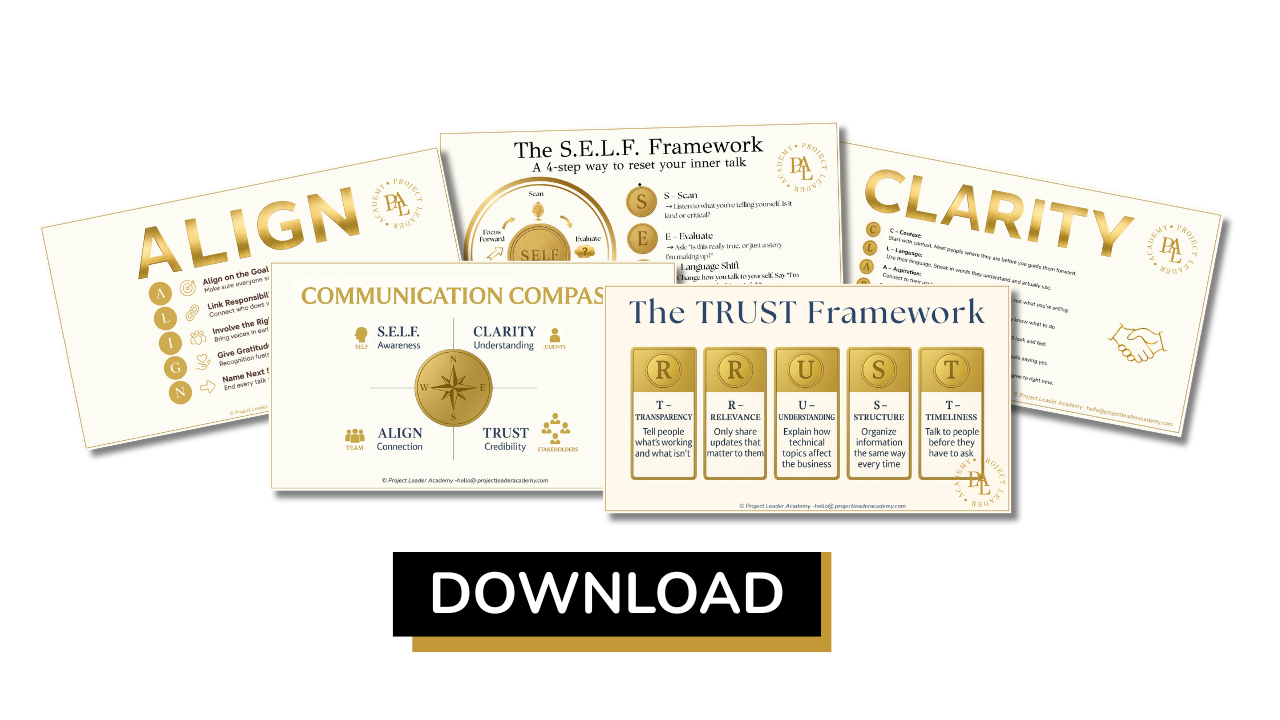The Four Conversations Every Leader Must Master

How to Communicate with Clarity, Confidence, and Connection — with Yourself, Your Customers, Your Team, and Your Stakeholders
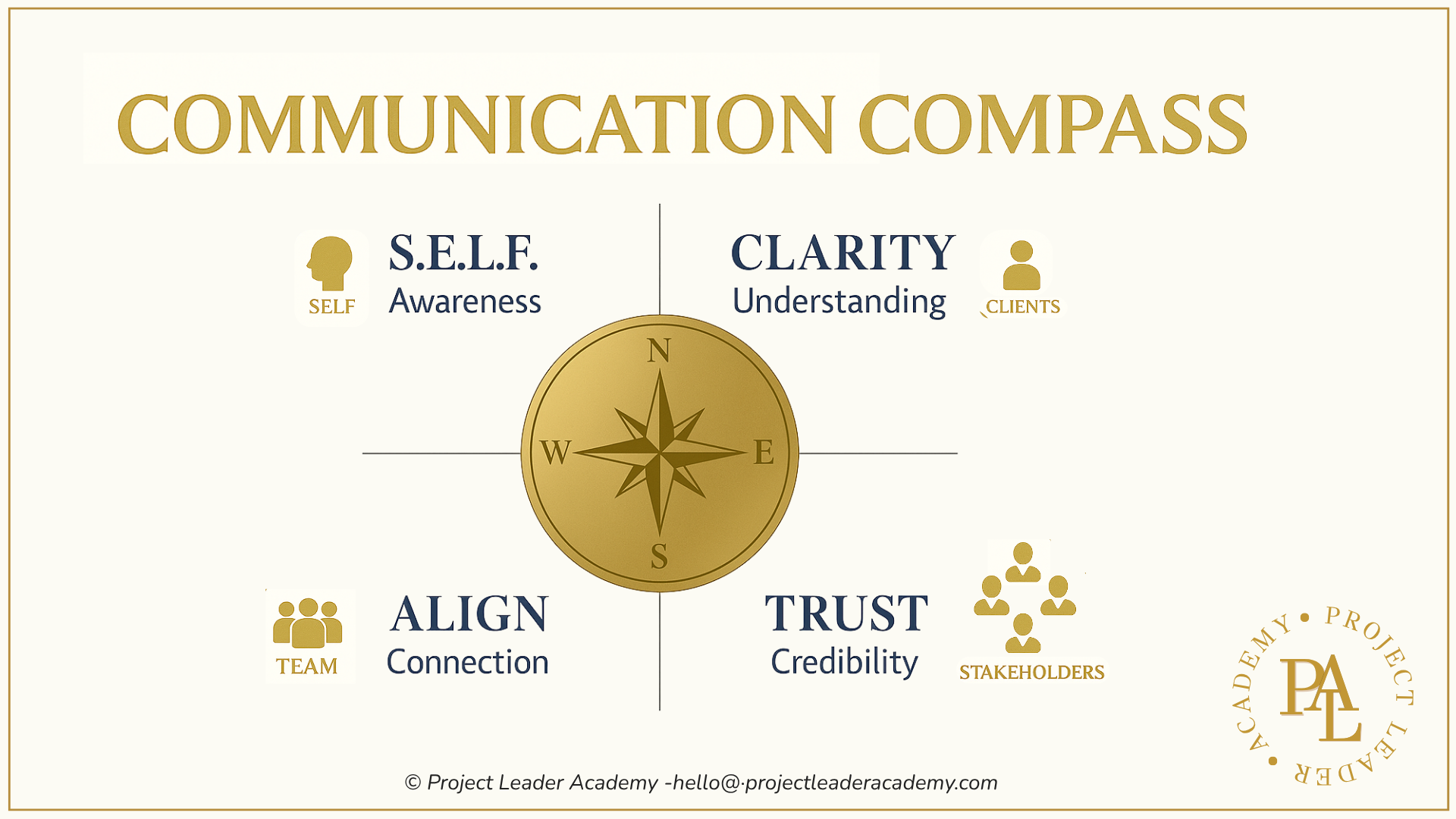
Leadership Doesn’t Fail Because of Strategy — It Fails Because of Communication
I’ve spent over two decades leading teams, training executives, and helping entrepreneurs plan multi-million-euro projects across industries from energy to media to construction.
Here’s the truth I’ve learned:
Leadership rarely fails because of bad ideas. It fails because of bad communication.
You can have the smartest strategy, the best plan, and the most capable team — but if people don’t understand you, don’t trust you, or don’t feel seen by you, things fall apart.
When communication breaks, alignment breaks. When alignment breaks, projects stall, motivation drops, and clients lose confidence.
I learned this the hard way.
Early in my career, I was leading a project worth €80 million. We had brilliant engineers, perfect spreadsheets, and airtight presentations. But behind closed doors, I could feel the tension. Everyone was “doing their job,” yet nobody was talking. The silence between departments was louder than any meeting.
That’s when it hit me — communication isn’t a soft skill. It’s a core business system.
Over time, I began to notice patterns in how great communicators operated. Whether they were Fortune 200 executives or small-business founders, the best leaders had mastered four distinct conversations:
- The one they have with themselves.
- The one they have with their customers.
- The one they have with their team.
- The one they have with their stakeholders.
Together, these became what I now call The Communication Advantage — four simple frameworks you can use every single day to lead with clarity, connection, and trust.
1. Talk to Yourself Like a Leader — The S.E.L.F. Framework
If I could teach only one skill, it would be this one. Because before you lead anyone else, you lead yourself.
Your internal voice is the most powerful communication channel you have. It’s the voice that sets the tone before every meeting, pitch, or conflict.

I’ve been there. I was a CEO leading 260 people. I consulted on projects worth €80 million. I helped grow an organization from 20 to 3,000 people — and watched revenue rise from €300 million to €3 billion. I’ve trained and coached thousands of leaders, executives, and entrepreneurs across industries, from government to tech, from construction to healthcare.
And everywhere I went, I heard the same inner stories:
- “I can’t speak up — I’m not the VP yet.”
- “I don’t have the title, so who am I to lead?”
- “I’m too young — they won’t take me seriously.”
- “I’m a small blonde woman — will they even listen?”
- “I’ve never done this before; maybe I should stay quiet.”
- “I don’t have the formal education or authority.”
Different industries. Same pattern. Limiting beliefs and negative self-talk kill more leadership potential than lack of skill ever will.
What I’ve learned — and what I teach in every leadership training — is simple: before you can persuade anyone else, you have to persuade yourself. You have to believe in your value before anyone else will see it.
In my programs, I often draw a simple heart model — three hearts connected in a circle: Love yourself → Love others → Be loved. It’s a reminder that confidence and trust start from within. The energy you bring to yourself is the same energy others will feel from you.
That’s why I created the S.E.L.F. Framework — a simple 4-step process to reset your inner dialogue and bring positive energy back to your leadership.
- S – Scan: Notice your inner narrative. Are you coaching yourself or criticizing yourself?
- E – Evaluate: Ask: “Is this thought true, or just a story I’m telling myself?”
- L – Language Shift: Replace pressure-based self-talk with progress-based self-talk. Instead of “I can’t fail,” say “I’m learning what works.”
- F – Focus Forward: Anchor on the next best step, not the last mistake.
When I use this method before high-stakes meetings, I walk in calm and clear. And when my clients apply it, they rediscover their voice — and others start listening.
Leadership always starts from the inside out.
2. Talk to Your Customers — The C.L.A.R.I.T.Y. Framework
Customers don’t buy the best service. They buy the one they understand the fastest.
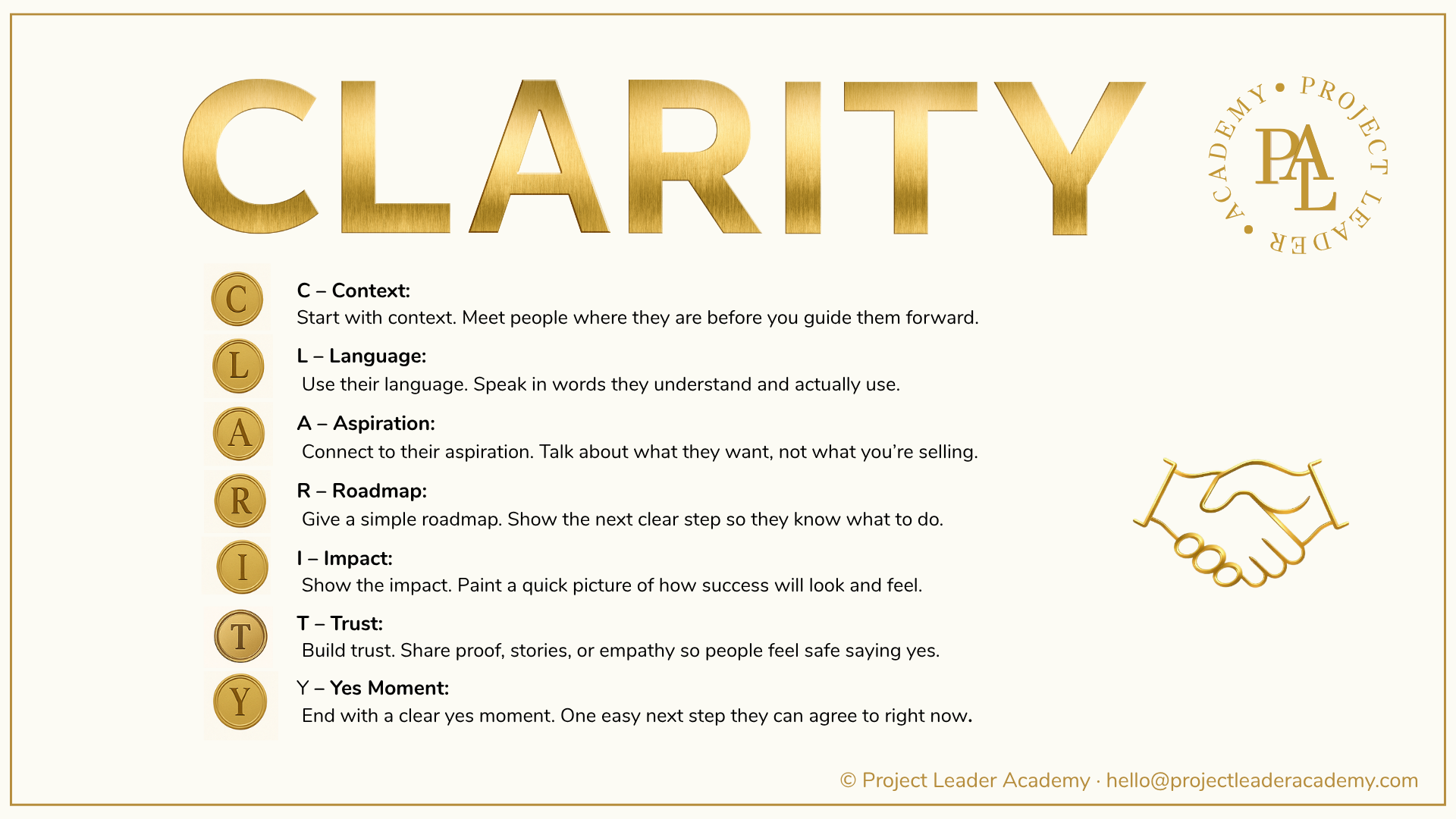
Years ago, I pitched a global hotel group on a technology project. We had a brilliant product — but my proposal was full of technical language: integration layers, data gateways, bandwidth optimization.
Halfway through, I saw it — that polite, blank stare executives get when they’re lost. We didn’t close the deal.
A few months later, I tried again — this time rewriting my message using plain language, focusing on outcomes:
“You’ll be able to show your guests a digital concierge in every room — saving your staff hours and improving guest satisfaction.”
Same product. Clearer message. Immediate yes.
That experience birthed the C.L.A.R.I.T.Y. Framework — seven steps to speak your client’s language:
- C – Context: Start where they are.
- L – Language: Use words they actually use.
- A – Aspiration: Speak to what they want, not what you sell.
- R – Roadmap: Show the clear next step.
- I – Impact: Paint what success looks and feels like.
- T – Trust: Add social proof or empathy.
- Y – Yes Moment: End with one simple call to action.
When I teach this to consultants or project leaders, they instantly see results — because clarity builds credibility faster than any credential.
3. Talk to Your Team — The A.L.I.G.N. Framework
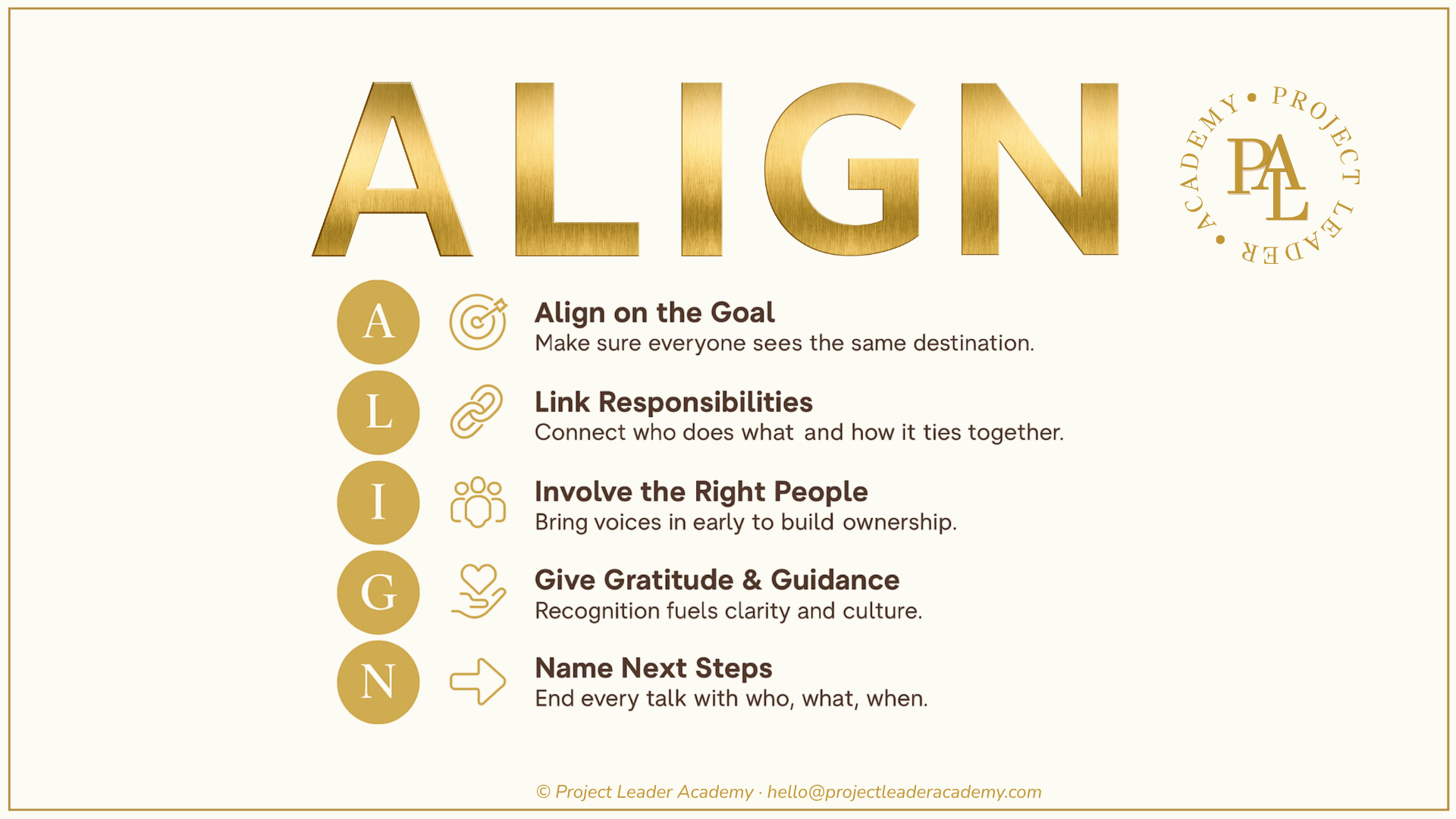
I remember leading a cross-cultural team spread across five countries. Different time zones, personalities, communication styles — chaos potential: high.
What saved us wasn’t technology; it was rhythm. Every Monday we started with one question:
“What are we trying to achieve this week — and how does it connect to the bigger picture?”
That question realigned everyone.
When people know why their work matters and how it connects, they stop waiting for orders and start taking ownership.
That’s the essence of A.L.I.G.N. — a framework that turns management into leadership:
A – Align on the Goal Start by making sure everyone sees the same destination. No assumptions, no guessing — alignment before action.
L – Link Responsibilities Connect who does what — show how each role ties into the bigger picture. People commit when they see their part in the whole.
I – Involve the Right People Bring the key voices into the room early — not after decisions are made. Involvement builds ownership.
G – Give Gratitude and Guidance Say thank you when it’s due, and offer direction when it’s needed. Your tone sets the culture.
N – Name Next Steps End every conversation with crystal-clear actions: who, what, when. No confusion, no delays.
I use A.L.I.G.N. in every virtual meeting. We got more done with less friction, and the team actually enjoyed our calls.
Communication isn’t about talking more — it’s about creating meaning together.
A.L.I.G.N. helps teams stay connected, coordinated, and confident — even under pressure.
When people know the goal, their role, and what happens next, teamwork flows naturally.
4. Talk to Stakeholders — The T.R.U.S.T. Framework
Stakeholders aren’t impressed by slides — they’re impressed by stability. They want to know: Are we on track? Do you have this under control?
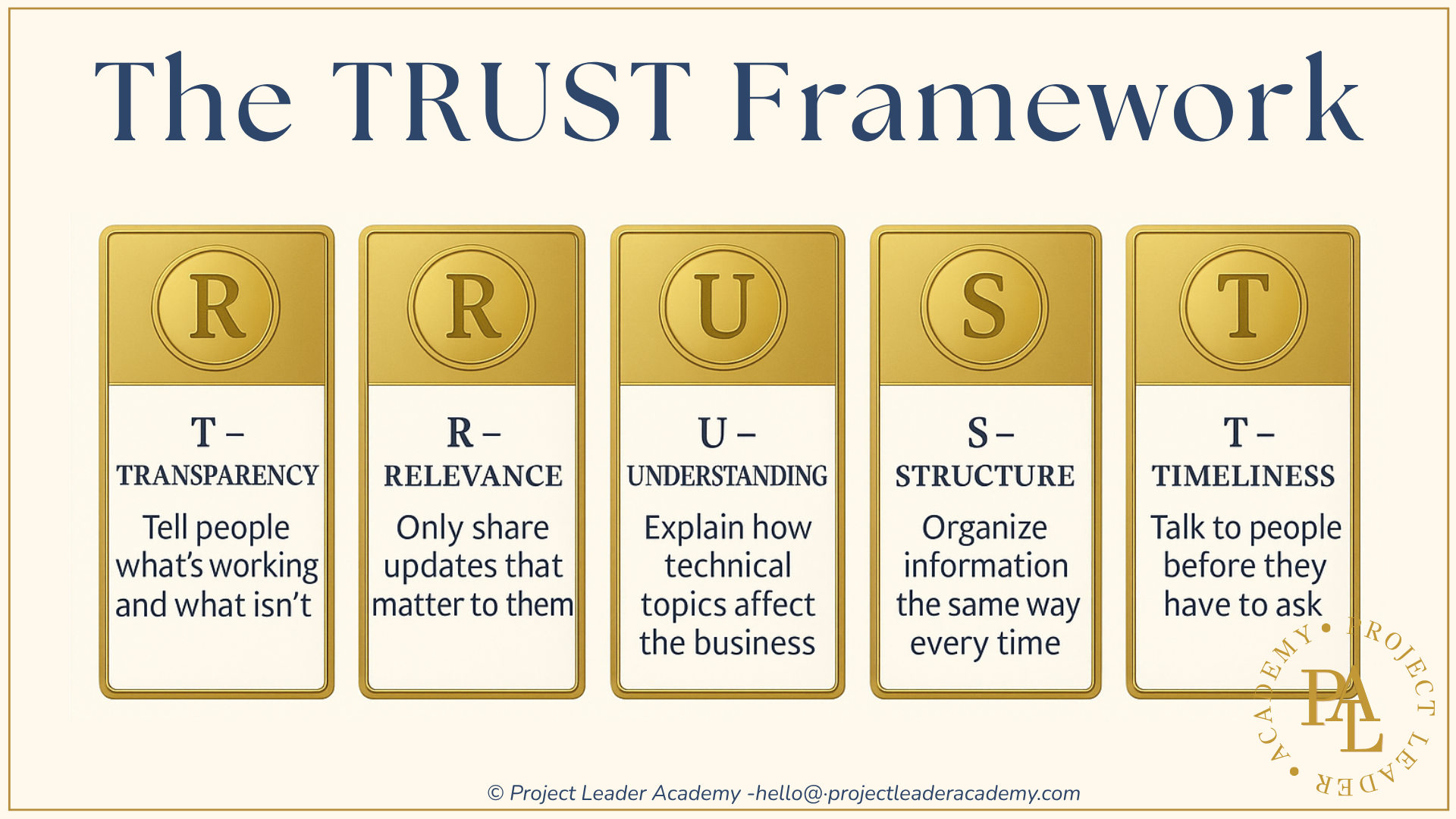
Years ago, I presented a project update to a board of directors. We had minor delays, and I was nervous — so I talked fast, dumped data, and over-explained. At the end, the CFO said, “So… are we on track or not?” Ouch.
That moment changed how I prepare for executive communication. I stopped defending and started delivering clarity.
Here’s the T.R.U.S.T. Framework I’ve taught ever since:
- T – Transparency: Share what’s working and what’s not.
- R – Relevance: Filter updates — only what matters to them.
- U – Understanding: Translate technical issues into business impact.
- S – Structure: Use a consistent format and rhythm.
- T – Timeliness: Communicate before they ask.
Now, when I update stakeholders, I keep it under five minutes:
“Two deliverables complete, one at risk. We’ve mitigated with an extra resource, so the final delivery date stays intact.”
Concise. Honest. Trust-building.
The Communication Compass: Bringing It All Together
These four frameworks — SELF, CLARITY, ALIGN, TRUST — form your Communication Compass. They’re simple, human, and repeatable.
| Who You Talk To | Framework | Focus | Outcome |
|---|---|---|---|
| Yourself | S.E.L.F. | Awareness | Inner clarity and confidence |
| Customers | C.L.A.R.I.T.Y. | Understanding | Clearer messaging and stronger sales |
| Team | A.L.I.G.N. | Connection | Collaboration and engagement |
| Stakeholders | T.R.U.S.T. | Credibility | Confidence and buy-in |
Together, they give you a system that works from the inside out. Because communication isn’t just a skill — it’s a leadership practice. And it starts with how you speak to yourself every morning.
Next Step:
Keep the Human Edge — Take the Frameworks With You
AI speeds things up. People move things forward.
Download the Communication Compass Pack™ — five executive-grade frameworks to lead every conversation with clarity:
S.E.L.F. — Reset your inner dialogue
C.L.A.R.I.T.Y. — Speak your client’s language
A.L.I.G.N. — Unite your team around what matters
T.R.U.S.T. — Build stakeholder confidence
Communication Compass — Connect all four conversations
→ Download the Free Framework Collection
Final Thought
I’ve worked with leaders on four continents, and I can tell you this: People don’t follow titles. They follow clarity.
Every project that succeeded in my life had one thing in common — not perfect plans, but clear conversations.
Start with your voice. Speak with intention. And watch your influence expand in every direction.

